M-87 Orkan
The M-87 Orkan (from Serbian: оркан, lit. 'hurricane') is a Yugoslav fully automated self-propelled multiple rocket launcher. The generic M-87 project was configured with 12 launch tubes mounted on a FAP 2832 truck. It has a range of about 50 to 120 km, with the ability to deliver warheads, anti-tank and anti-personnel mines. The production of Orkan M-87 ceased in the early 1990s due to breakup of Yugoslavia.
| M87 LRSV | |
|---|---|
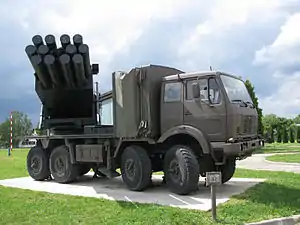 Former Croatian M87 Orkan in Museum | |
| Type | Self-propelled multiple rocket launcher |
| Place of origin | Yugoslavia |
| Production history | |
| Designer | Military Technical Institute[1] |
| Specifications | |
| Mass | 32t |
| Length | 9 m (29 ft 6 in) |
| Width | 2.64 m (8 ft 8 in) |
| Height | 3.84 m (12 ft 7 in) |
| Crew | 5 |
Main armament | 262 mm x 12 Orkan ll x 4 |
| Maximum speed | 80 km/h (50 mph) |
History
Development started as a joint Yugoslav and Iraqi project under the name of KOL-15 with professor Obrad Vučurović as a concept designer and chief engineer on the project.[1] In early talks with Iraq, Yugoslavia offered two options:[2]
- Development of a MRL with 12 barrels and a 50 km range
- Development of a MRL with 4 barrels and a 120 km range
Iraq chose the first option as did Yugoslavia.
At the start of development, two prototypes were built: one for Yugoslavia and one for Iraq. In accordance with requests from purchasers, rockets were developed with cluster warheads.
According to the chief operating officer of the Artillery department of Military Technical Institute professor Obrad Vučurović,[3] Orkan was never a copy of any previous designs. The Yugoslav doctrine when developing the system was based on the premise that countries who copy designs are at least five years behind those who have the weapons developed.[2]
Characteristics
One battery[4] of M-87 Orkans consists of:
- four 8×8 launchers
- four 8×8 resupply vehicles (each with 24 rockets)
- one 8×8 command post vehicle
- two 4×4 topographic survey light vehicles
- two 4×4 observation post-light vehicles
- one 4×4 meteorological survey vehicle
The FAP 2832 vehicle with its base platform is fitted with a central tyre pressure regulation system which is operated by the driver from within the cab, and to provide a more stable firing platform. Four stabilisers are lowered to the ground by remote control, one at either side to the rear of the second roadwheel and two at the very rear. When travelling, the launcher is traversed to the front and the whole launcher is covered by a tarpaulin cover with integral bows.
Rockets
The rocket is 4.6 metres long and it is packed in a glass-ceramic housing and transported by vehicle. Rockets are reloaded by the FAP 3232 with a built-in crane. The rocket speed is 1000 m/s. Rockets with extended range are 4.88 m long and weigh 404 kg. A battery of 4 launchers with 16 barrels and 192 rockets can cover a target area of 3–4 km².[5]
The following types of rockets are known:[5][6][7]
- M-87-APHE with a fragmentation warhead to 91 kg. Range 50 km.
- M-87-APHE-ER with a fragmentation warhead to 91 kg. Range 65 km.
- M-87-PFHE-ER pre-fragmented warhead containing double-size balls. Range 65 km.
- M-87-ICM-AT with 288 piece shaped charge bomblets type KB-2 . Range 50 km.
- M-87-ICM-AP with 420 piece splinter bomblets. Range 50 km.
- M-87-AT with 24 piece YU-S-AT (KPOM) mines with Magnetos. Range 50 km.
Some of the rockets are no longer in production.
Features
Unique features at the time of introduction (1987) when compared to other MRLs operational at the time include:[5][8]
- Ability to disperse anti-tank or anti-personnel mines up to 50 km from the firing location.
- Semi-automatic loading.
- Preparations to fire take two minutes.
- Automatic leveling. Automatic Leveling of weapon was very precise. The system has a TV camera corrector for correcting missile path.
- Automatic barrel sight.
- Hard chromed barrels without the need for cleaning.
- Mines KB-2 with wings and parachutes with two fuses (magnetic and mechanism for self-destruction after 24 or up to 48 hours)[2]
According to Obrad Vučurović,[3] Orkan's main feature was the ability to disperse anti-tank or anti-personnel mines from 5 to 50 km from the firing location.
Modifications and versions
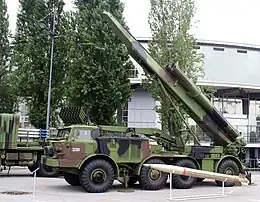
There were a few modifications of Orkan M-87:
- The first modification was made by Army of Republika Srpska with two barrels placed on Luna R-65 launcher (ZIL-135).
- Serbia and Montenegro modified Krupp M-418/37 and placed two Orkan barrels on it.
- Serbia developed the M-96 Orkan II modification. The simplest solution was to integrate four 262mm launch tubes on a ZIL-135 launcher as it required minimum investment. The basic purpose of these modified launchers can be restored.[9] Newly developed rockets increased range of Orkan II to 65 km.[6]
- Orkan CER developed by Yugoimport SDPR based on KamAZ-6350.[7]
- Dominator M2/12 MLRS multi-caliber multiple launch rocket system developed by Yugoimport SDPR which uses 16 262mm Orkan rockets.[10]
TOROS artillery rocket system
In 1990s Turkey faced USA reluctance to share modern defense technology. In order to have domestic supply of multiple rocket launcher rockets and domestic launchers Turkey used reverse engineering and shortcuts in order to develop its own versions. In order to have a supply of 227mm rockets they reverse engineered M270 Multiple Launch Rocket System M26 rocket under project designation SAGE 227.[11] For continuing work on development of domestic MRLS Turkey obtained Orkan M-87 documentation, launcher and rockets from Bosnia and Herzegovina's "Bratstvo Novi Travnik" factory in 1995. They used them for development of a domestic 260mm rockets and launcher thus shortening development for more than 5 years. First launches of new 230 and 260mm rockets respectively based on 227 M26 and 262 Orkan rockets produced in Turkey from Orkan M-87 launcher were conducted in April 1999.[12][13]
Operational history
In May 1995, the Republic of Serbian Krajina used M-87 Orkan to attack civilian population of Zagreb after Croatian forces captured territories previously held by Serbian forces.[14][15]
Operators
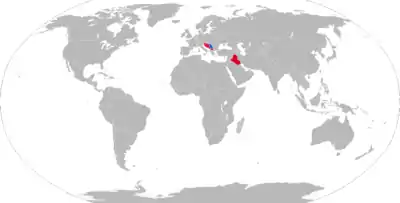
Former operators
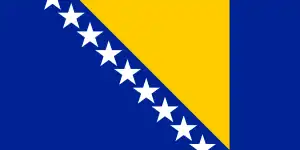 Bosnia and Herzegovina - 1 non-operational unit in Banja Luka,[16] 1 completed and 3 partially assembled units destroyed[17] along with rockets.[18]
Bosnia and Herzegovina - 1 non-operational unit in Banja Luka,[16] 1 completed and 3 partially assembled units destroyed[17] along with rockets.[18]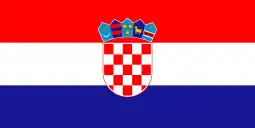 Croatia - 1[17] in reserve due to lack of adequate rocket ammunition, 1 in a museum
Croatia - 1[17] in reserve due to lack of adequate rocket ammunition, 1 in a museum.svg.png.webp) Iraq - four launchers and four reload vehicles.[19] In 2000-2001, the reload vehicles were transformed into launchers, using modified SM-90 launchers from the S-75 Dvina SAM system, with six tubes instead of 12.[20] No longer operational.
Iraq - four launchers and four reload vehicles.[19] In 2000-2001, the reload vehicles were transformed into launchers, using modified SM-90 launchers from the S-75 Dvina SAM system, with six tubes instead of 12.[20] No longer operational..svg.png.webp) Yugoslavia - 9 + 1 prototype[2][21]
Yugoslavia - 9 + 1 prototype[2][21]
See also
- Astros II MLRS - an earlier, very similar system
- TOROS - Turkish rocket artillery system developed by reverse engineering the M-87 Orkan.
- M270 Multiple Launch Rocket System
- Fajr-5
- BM-30 Smerch
References
- "Vojnotehnicki Institut".
- "Interview with the chief constructor in Serbian Armed Forces Magazine Odbrana" (PDF). Odbrana.mod.gov.rs. Archived from the original (PDF) on 25 November 2015. Retrieved 24 November 2015.
- "Obrad Vucurovic, Rocket design elements, Launcher design problems, Biography and Textbooks, Weapon systems gallery". Vucurovic.com. 1 March 2008. Archived from the original on 24 June 2013. Retrieved 24 November 2015.
- "M87 Orkan Multiple Launch Rocket System". Military-Today.com. Retrieved 24 November 2015.
- "262-мм реактивная система залпового огня M87 Orkan | Ракетная техника". Rbase.new-factoria.ru. Retrieved 24 November 2015.
- "R267 262mm". www.edepro.com. Archived from the original (GIF) on 20 June 2013. Retrieved 26 September 2023.
- "Orkan CER Multiple Launch Rocket System". Military-Today.com. Retrieved 24 November 2015.
- "ISTINA O ORKANU" (PDF) (in Serbian). Odbrana.mod.gov.rs. Archived from the original (PDF) on 25 November 2015. Retrieved 24 November 2015.
- "Војска Србије | Наоружање Копнене војске | Артиљерија | Лансер ракета самоходни четвороцевни 262 mm М87 ОРКАН". Vs.rs. Archived from the original on 26 September 2015. Retrieved 24 November 2015.
- "Dominator M2/12 multi-caliber MLRS Multiple Launch Rocket System technical data sheet specifications | Serbia Serbian army artillery vehicles systems UK | Serbia Serbian Army military equipment UK". Armyrecognition.com. 15 November 2013. Retrieved 24 November 2015.
- "Royal Artillery".
- TUBITAK 1990lar (in Turkish)
- Toros 260 image
- "Unprofor". Archived from the original on 11 November 2013. Retrieved 9 January 2018.
- Roger Cohen (4 May 1995). "Rebel Serbs Pound Zagreb for Second Day". New York Times. Retrieved 2 January 2010.
- "Muslimanska komponenta tzv. Vojske BiH pokušala oteti Orkan iz Banja Luke". Novosti.rs.sr. 20 November 2007. Retrieved 24 November 2015.
- "Наоружање - ОРКАН". YouTube. Archived from the original on 5 December 2013. Retrieved 24 November 2015.
- "Landmine & Cluster Munition Monitor | Country Profiles | Bosnia and Herzegovina | 2012 | Cluster Munition Ban Policy". Archived from the original on 5 October 2013. Retrieved 25 June 2013.
- Altobchi, Ali; Cooper, Tom; Fontanellaz, Adrien (2022). Al-Hussein: Iraqi indigenous conventional arms projects, 1980-2003. Warwick, UK: Helion & Company Publishing. p. 22. ISBN 978-1-914377-18-1.
- Altobchi, Ali; Cooper, Tom; Fontanellaz, Adrien (2022). Al-Hussein: Iraqi indigenous conventional arms projects, 1980-2003. Warwick, UK: Helion & Company Publishing. p. I. ISBN 978-1-914377-18-1.
- ARG. "M87 Orkan Multiple Launch Rocket System". Military-Today.com. Retrieved 24 November 2015.